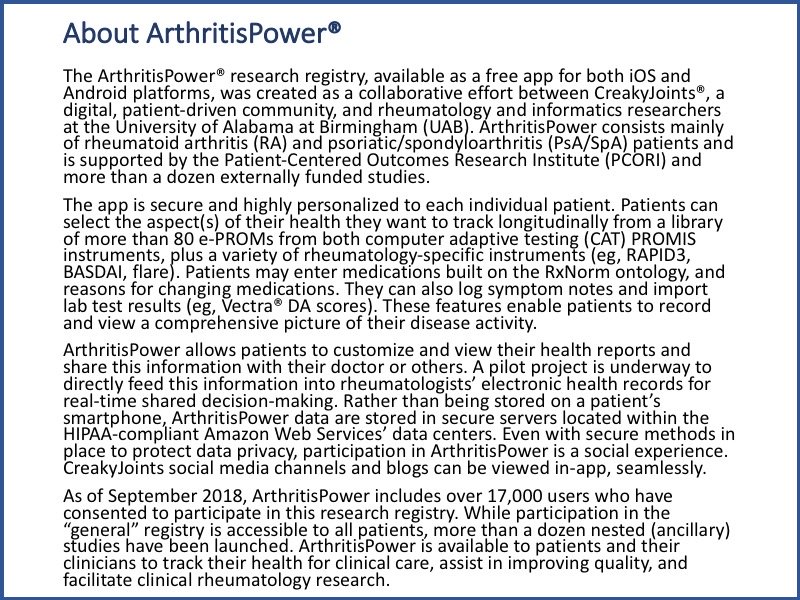Will Electronic Patient-Reported Outcome Measures (e-PROMs) Improve Treat-to-Target Strategies?
Since current treat-to-target practice relies on disease activity measured at a single point in time, electronic patient-reported outcome measures (e-PROMs) represent a potentially powerful tool for monitoring patient disease activity between office visits.
W. Benjamin Nowell, PhD


Dr Nowell is Director of Patient-Centered Research, CreakyJoints®.
Treat-to-target (T2T) is now the gold standard for the management of rheumatoid arthritis (RA).1,2 During a clinical visit, a person with RA and his or her rheumatologist discuss treatment goals based on an evaluation of current symptoms, laboratory results, and physical examination findings.
Since current T2T practice relies on disease activity measured at a single point in time, electronic patient-reported outcome measures (e-PROMs) represent a potentially powerful tool for monitoring patient disease activity between office visits. In contrast to a clinical measure collected by a physician or other healthcare professional, a patient-reported health outcome measure is reported directly by the patient who experiences it.
Electronic patient-reported outcome measures are collected using such methods as computers, smartphones, or telephone systems. Thus, e-PROMs can be remotely conveyed by patients via smartphone mobile app such as ArthritisPower® patient-centered research registry (please click sidebar for more information about ArthritisPower).
As e-PROMs are increasingly used in health research, for regulatory purposes, and even as part of clinical care, apps with e-PROMs for standardized symptom data capture are usually available only in the context of research studies.3 At the Annual European Congress of Rheumatology (EULAR 2018) held in Amsterdam earlier this year, CreakyJoints presented data that highlight the need to conduct more research to determine how best to use e-PROM data within a clinical T2T framework.
We surveyed 257 participants with RA, 70% of whom were being treated with DMARDs (traditional or biologic) yet were still experiencing high disease activity as measured by the RAPID3 (median 18 on 0-30 scale) via ArthritisPower smartphone app.4 Among the 70% of patients with high disease activity, fewer than 40% reported that they were offered a treatment change at their last physician visit. Of those offered a treatment change, 71% agreed to a switch. But among patients who switched treatment, only about a quarter said they intensified therapy because they had not met predefined targets for disease control. Instead, most patients stated they wanted to change treatment because of their own perception of high disease activity or disease worsening. This may imply that treating to target means something different for patients than it does for physicians, and more patient education may be helpful.
Since high disease activity based on e-PROM data collected remotely could theoretically trigger a patient-doctor discussion about possible therapy change, further research is needed to determine how best to use such data and which e-PROMs are most appropriate to prompt reexamination of a treatment plan.
References:
1. Singh JA, Saag KG, Bridges SL Jr, et al. 2015 American College of Rheumatology guideline for the treatment of rheumatoid arthritis. Arthritis Care Res. 2016;68:1-25.
2. Stoffer MA, Schoels MM, Smolen JS, et al. Evidence for treating rheumatoid arthritis to target: results of a systematic literature search update. Ann Rheum Dis. 2016;75:16-22.
3. Luo D, Wang P, Lu F, Elias J, Sparks JA, Lee YC. Mobile apps for individuals with rheumatoid arthritis: a systematic review. J Clin Rheumatol. 2018 Jun 21. doi: 10.1097/RHU.0000000000000800. [Epub ahead of print]
4. Stark JL, Yassine M, Nowell WB, et al. Barriers to rheumatoid arthritis treatment optimisation: real-world data from the ArthritisPower Registry. Presented at: Annual European Congress of Rheumatology (EULAR 2018); June 13-16, 2018; Amsterdam, The Netherlands. Abstract THU0159.